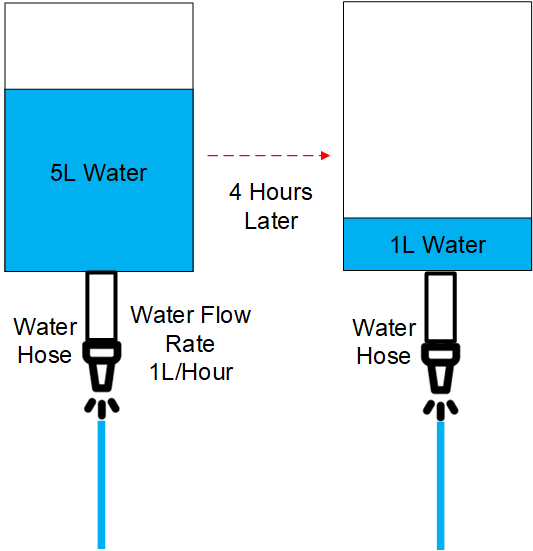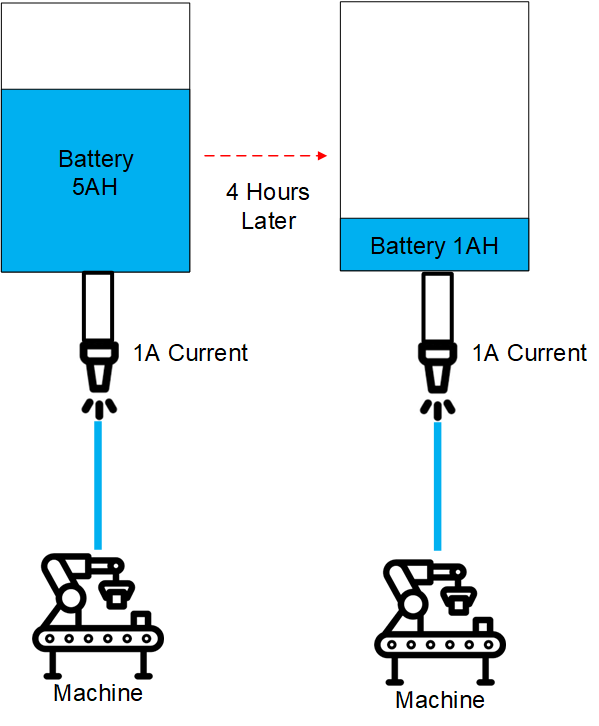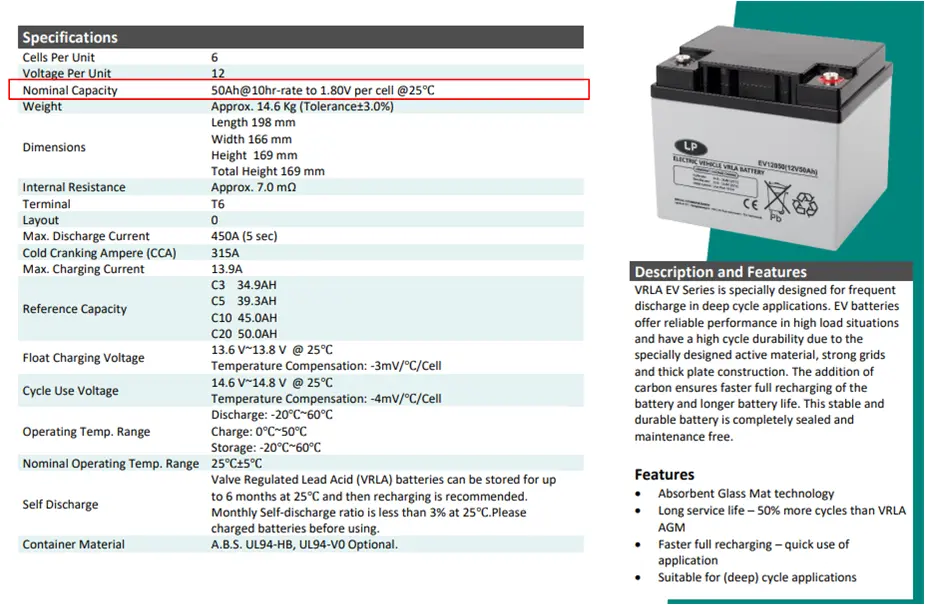Wh to Ah Conversion
Table of Contents

Wh to Ah Conversion
Wh and Ah are both units used to measure batteries, but they have different meanings. When configuring a battery UPS, we need to understand their different meanings to help us better configure the UPS battery capacity according to our own scenarios. This article attempts to explain the meaning of Wh and Ah and Wh to Ah conversion in a simple way.
Easy Way to Understand Ah - Ampere-hour
First, let’s understand Ampere-hour. Here is the definition of Ampere-hour:
An ampere-hour or amp-hour (symbol: A⋅h or A h; often simplified as Ah) is a unit of electric charge, having dimensions of electric current multiplied by time, equal to the charge transferred by a steady current of one ampere flowing for one hour, or 3,600 coulombs.
Source:Ampere-hour
I personally think this explanation is too academic, and I still can’t actually understand what Ampere-hour is. To understand this concept, let’s take an example:

Suppose we have a water tank with 5L of water in it. We install a hose on it and it flows water out at a rate of 1L/hour. Then after 4 hours, 4L of water will flow out and 1L of water will remain in the water tank. We can also say that after 5L of water is installed in this water hose, it can supply water out for 5 hours and finally run out.

Using the water tank example above, let’s understand what Ampere-hour is. We can think of the battery as a water tank, and the electricity stored in it as water. When we have a device, the electricity it consumes when it runs is similar to water. First, let’s explain the Ampere-hour formula:
Battery Capacity(In Ah) = Current(A)*Time(hour)
Based on this formula, let’s look at the example in the figure above. If we have a machine that runs at a current of 1A, and our battery is 5Ah, what will happen after running for 4 hours? Obviously, the machine consumed 4ah of battery power in 4 hours, and the battery had 1ah remaining.
Battery Capacity Used = Current(A)*Time(hour)
= 1A*4hours
= 4Ah
Battery Capacity Left in Battery = Battery Capacity Initial – Battery Capacity Used
= 5Ah – 4Ah
= 1Ah
After the above examples, we have basically understood the actual meaning of the unit Ah. In actual work, we do not need to know the exact definition of Ampere-hour, but we just need to truly understand it. But please note that we have actually shielded many other issues in the explanation to facilitate understanding. We will expand on this step by step later.
Real Case to Explain Ampere-hour

The above picture shows a typical lead-acid battery. We can see that its voltage is 12V and the battery capacity is 50Ah. Note that the voltage parameter is very important and will be discussed in detail in the following chapters when discussing Wh to Ah Conversion.

Based on this battery, we use an LED light to build a basic circuit. We know that the battery parameters are 12V and 50Ah. We use a 12V 1A LED light. Based on this circuit, let’s calculate how long this battery can power the LED light?
We have already got the following formula in the previous chapter, so we only need to change it to calculate how long this battery can power the LED light.
Battery Capacity(In Ah) = Current(A)*Time(hour)
Time(Hour) = Battery Capacity(In Ah)/Current(A)
= 50Ah/1A
= 50hours
Therefore we can calculate that this battery can power the LED light for 50 hours.

What if we use a more powerful LED light? We can also use the formula to calculate:
Time(Hour) = Battery Capacity(In Ah)/Current(A)
= 50Ah/2.5A
= 20hours
Wh to Ah Conversion
In the above two chapters, we have explained the concept of Ah and related calculations. The examples given are ideal for easy understanding. However, the reality is much more complicated. The reason why Wh to Ah conversion is introduced is to solve more complicated situations in reality. Suppose we have the following circuit model, then the situation becomes much more complicated:

As shown in the figure above, we have a 12V50Ah battery and a 24V1A LED light. Because the voltage of the LED light is different from the battery voltage, we cannot use the battery to drive the LED light directly. We need to add a DC12V to DC24V converter. So how do we calculate how long the battery can drive the LED light?
First of all, please note that the formula we described above: Battery Capacity (In Ah) = Current (A) * Time (hour) has a premise that the voltage of the load and the voltage of the battery are the same. But in our current example, the voltage of the load power supply and the battery are different. At this time, we can’t use this formula directly to calculate, we need to use Wh to Ah conversion.
First of all, we need to understand that there is a premise when using Ah as a unit to measure battery capacity. For example, if we have a battery A with a capacity of 12V50Ah and another battery B with a capacity of 12V25Ah, then we think that the capacity of battery A is twice that of battery B. The premise here is that their voltages are the same. For example, when we calculate the power supply of a 12V1A LED light with a 12V50Ah battery as follows:
Time(Hour) = Battery Capacity(In Ah)/Current(A)
= 50Ah/1A
= 50hours
The voltage used by the LED lamp here is the same as the battery voltage, both are 12V, so we can calculate this way.
At the time, when the load voltage is different from the battery voltage, we cannot calculate this way. We need to convert Ah to Wh. Wh is the true benchmark for representing power. Wh is determined by two parameters of the battery, voltage and ampere-hour. The formula is as follows:
Battery Capacity(In Watt-hour) = Battery Voltage(V)*Battery Capacity(In Ah)
This formula may seem confusing when you first encounter it. Let’s take a simple example. First, let’s put aside the concepts of Wh and Ah and look at the following example:

Now we have two rectangles, rectangle A is 50cm long and 12cm wide, and rectangle B is 24cm long and 10cm wide. How many rectangles of B can fill the area of A?

We have learned this calculation in elementary school. It is to calculate the area for comparison. The size of the area is obtained by multiplying the length of the rectangle by the width.

We use the area comparison method to understand the relationship between battery capacity, voltage, current, and time. If a 24V10A LED light runs for 1 hour, how big a battery do we need? We need a battery with a voltage of 24V and a capacity of 10Ah. If we apply the formula to calculate its capacity:
Battery Capacity(In Watt-hour) = Battery Voltage(V)*Battery Capacity(In Ah)
= 24V*10Ah
= 240Wh

We continue to use the area method to understand, then the capacity of a 12V50Ah battery is:
Battery Capacity(In Watt-hour) = Battery Voltage(V)*Battery Capacity(In Ah)
= 12V*50Ah
= 600Wh
Battery Capacity LED Light Need for One Hour(In Watt-hour) = LED Light Voltage(V)*Battery Capacity Needed for One Hour (In Ah)
= 240Wh
So that means the LED Light can run 600/240 = 2.5 hours.
Summary of Wh to Ah Conversion
Summarizing the knowledge we have described in the previous article, the summary is as follows:
(1) When comparing the capacities of two batteries, if their voltages are the same, their sizes can be determined directly by comparing the capacities marked in Ah.
(2) When the battery and load voltages are the same, the load runtime can be calculated using the following formula:
Battery Capacity(In Ah) = Current(A)*Time(hour)
(3) When comparing batteries, Wh to Ah conversion is required. First, calculate the battery capacity in Wh of each battery, and then compare them by Wh. The formula can be used:
Battery Capacity(In Watt-hour) = Battery Voltage(V)*Battery Capacity(In Ah)
(4) The battery and load voltages are different. To calculate the runtime that the battery can support for the load, you need to calculate the power required by the load for one hour in Wh, and then calculate the battery capacity in Wh. Then you can calculate the runtime.
In short, Wh is the ultimate benchmark for measuring the capacity of a battery or the load it can discharge over a certain period of time.

